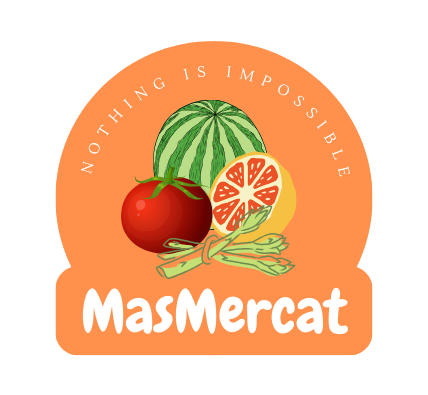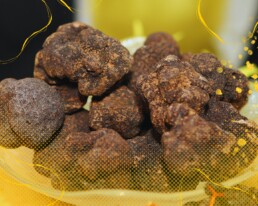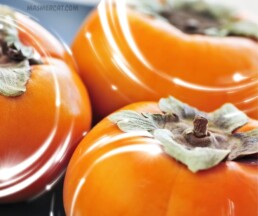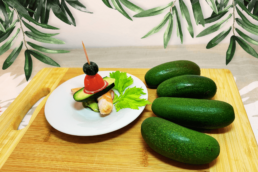The Flat Peach and Flat Nectarine: Sweetness that Refreshes
During the hot summer months, few fruits are as refreshing and appetizing as the flat peach, also known as doughnut peach, paraguaya or its variant flat nectarine. This fruit, with its flattened shape and intensely sweet flavor, has won over taste buds around the world—especially in Spain, where its consumption grows year after year. But where does this peculiar fruit come from? What health benefits does it offer? And how should we consume it to make the most of its qualities?
Origin of the Flat Peach
The flat peach is a variety of peach (Prunus persica var. platycarpa), and its flat shape is the result of a natural mutation. Its origin dates back to China, where primitive versions were already being cultivated more than 2,000 years ago, as documented in ancient texts describing China’s long agricultural tradition. From there, it spread to Persia, the Mediterranean, and Europe, eventually reaching the Americas.
Its flattened form is believed to have arisen spontaneously as a mutation of the common peach tree, later selected for its intense flavor, thin skin, and juicy flesh
Different Names Around the World
This fruit is known by different names depending on the country or region:
Spain: paraguayo or platerina (the latter usually refers to the smooth-skinned variety, similar to a nectarine).
Latin America: durazno chato, durazno paraguayo, or melocotón plano.
English: doughnut peach, Saturn peach.
France: pêche plate.
Italy: pesca piatta or saturnina.
This variety has become popular in many countries for being sweeter and less acidic than traditional peaches, and for being easier to eat since the pit separates easily from the flesh.
Consumption in Spain and Worldwide
Spain is one of the leading producers and exporters of flat peaches in Europe, particularly in regions such as Murcia, Aragón, and Catalonia. The season runs from June to September, making it a star fruit of the summer. Spanish consumers value it for its sweetness, aroma, and pleasant texture.
Beyond Spain, the flat peach has also gained a presence, especially in gourmet markets and healthy eating circles. Countries such as the United States, Italy, and France have incorporated this fruit into their fresh produce markets as well as into products like juices, jams, and desserts.
Nutritional Properties
The flat peach is a highly nutritious fruit, low in calories and rich in water—making it ideal for hydration and weight-control diets. Below is an approximate nutritional breakdown per100 grams:
Nutrient | Approx. Amount |
Calories | 39 kcal |
Water | 87% |
Carbohydrates | 9.5 g |
Natural sugars |
|
Fiber | 1.5 g |
Protein | 0.9 g |
Fat | 0.3 g |
Vitamin C | 10 mg (17% VD) |
Vitamin A (beta-carotene) | 326 IU |
Potassium | 190 mg |
Magnesium | 9 mg |
Health Benefits
Eating flat peaches offers a range of benefits that go beyond their refreshing taste: they provide natural hydration, deliver antioxidants that help combat oxidative damage, supply fiber that supports healthy digestion, improve cardiovascular function thanks to their potassium content, and are also ideal for a healthy diet as they are low in calories.
What’s the Difference Between the Flat Peach and the Flat Nectarine?
The difference lies not in the species, but in the skin texture and subtle variations in taste and appearance.
Both belong to the same species (Prunus persica var. platycarpa ), a flat variety of peach.
Characteristic | Flat Peach | Flat Nectarine |
Skin | Velvety (with fuzz) | Smooth (no fuzz) |
Flavor | Sweet, juicy, aromatic | Sweet, firm, slightly crisper |
Appearance | Mixed, less uniform colors | Brighter, more uniform colors |
Origin | Flat peach variety | Flat, fuzz-free variety, similar to nectarine |
How to Enjoy it
The flat peach can be enjoyed in many ways: The traditional one is to eat the fruit well-washed and in season, or to add it to a good salad to bring a sweet touch. At breakfast or as a dessert, it pairs wonderfully with yogurt or curd. Another very healthy option is to grill it, which enhances its sweetness and makes it an ideal side dish.
Finally, you can make the most of its sweetness by blending it with plant-based milk or yogurt and ice, without added sugar, resulting in a refreshing, nutritious drink with balanced sugar content—perfect for beating the summer heat. And if you want even more nutrients, you can add seeds such as chia or flax. In smoothies, blended with plant-based milk or yogurt, ice, and no added sugar for a refreshing, nutrient-rich summer drink. For an extra nutritional boost, add seeds like chia or flax.
This summer, you can enjoy the refreshing taste of the flat peach a healthy, versatile, and delicious fruit that continues to earn its place in the Mediterranean diet and beyond.
So if you haven’t tried it yet, summer is the perfect time to savor this juicy, delightful gift of nature.
For more information, explore our products here.
Apricot: The King of Summer
The apricot is not just a symbol of summer—it's a fruit from the Far East, a great ally for health, and a delight in the kitchen.
Its Origin
The apricot belongs to the Rosaceae family and its scientific name is:
Prunus armeniaca
Interestingly, the scientific name refers to Armenia, one of the countries through which the fruit spread to Europe, although its origin traces back to Central Asia and China.
A Bit of History: The Apricot in Spain
It is believed that the Arabs introduced apricot cultivation to the Iberian Peninsula during the Middle Ages. In Arabic, it was known as al-barqūq, a word from which the current Spanish name albaricoque is derived.
A very Spanish curiosity: in Murcia, the main producing region, the apricot is so ingrained in the local culture that there are popular sayings like:
"You’re more Murcian than an apricot"
And rightly so, since Murcia leads national apricot production, with traditional varieties like Bulida, highly prized for their sweet and juicy flavor.
Each region harvests a fruit that reflects the characteristics of its soil, climate, variety, and the care given by the farmer—making each apricot uniquely distinctive. Here’s an example:
Nutritional Content of Apricots (per approx. 100g)
_______________________________________________________________
Nutrient Approx. Amount
Energy 48 kcal
Water 86%
Protein 1 g
Carbohydrates 11 g
Natural Sugars 9 g
Fiber 2 g
Fats 0.4 g
Vitamin A 96 mcg (12% RDI)
Vitamin C 10 mg (12% RDI)
Potasiumm 259 mg
Beta-carotene 1094 mcg
________________________________________________________________
✅ Low in calories, ideal for snacking
✅ Rich in vitamin A and beta-carotene, protects skin and eyesight
✅ Source of vitamin C, boosts the immune system
✅ Contains potassium, supports heart and muscles
✅ Provides fiber, beneficial for digestion
Apricots and Sun Protection
Thanks to their beta-carotene and antioxidant content, apricots help protect the skin from sun damage and promote a healthy tan… though they should never replace sunscreen!
Season and Growing Regions
In Spain:
• Season: April to July
• Main regions: Murcia, Valencia, Alicante, Aragón
Worldwide:
• Turkey – world leader
• Iran, Uzbekistan – historic major producers
• Italy, France – known for high quality
•Morocco and Tunisia – key in the Mediterranean
Quick Regional Summary
| Region | Notable Varieties | Climate | Main Season |
|---|---|---|---|
| Murcia | Bulida, Currot, Mitger, Redixia | Dry Mediterranean, hot summers | April - June |
| Comunidad Valenciana | Canino, Ginesta, Currot | Mild Mediterrean, sea breeze | May - July |
| Aragon | Moniquí, Mitger, Bulida, Faralia | Mild Continental, warm summers | Late May - July |
Each area brings its own signature to the apricot: from the sweetness and size of those from Murcia, to the balance and juiciness of those from Valencia, and the intense, traditional flavor of those from Aragón.
Choose your favorite and enjoy summer naturally! ☀️🍑
How to Eat and Enjoy Them
✔️ Fresh, as a snack or in salads
✔️ Dried, perfect for snacking or baking
✔️ In jams and compotes
✔️ In savory dishes like tagines and stews
✔️ In tarts, yogurts, smoothies, or desserts
A bite of apricot is history, health, and flavor. Take advantage of the season to enjoy its benefits and sweetness—and remember:
If you want to care for yourself from the inside out and show off radiant skin, the apricot is your ally.
For more information, explore our products here
Truffle: Sophistication in Your Kitchen
This past winter, we had the wonderful opportunity to experience life in the Aragonese countryside. Alongside seasoned farmers, we witnessed the fascinating process of truffle harvesting. It was a day full of adventure—through ravines, dirt roads, herds of livestock, snow, and of course, breathtaking views of the mountains straddling the border between the Valencian Community and Aragon. A memory that inspired us to write and share this article with you.
Guided by our bold and knowledgeable friends, we stepped into a world entirely new to us, eager to see how these elusive fungi would reveal themselves. But none of it would have been possible without the star of the day—our truffle-hunting companion with a keen and well-trained nose.
Her name was Luna, a clever little dog who reigned supreme when it came to sniffing out delicious truffles. She surprised us several times with her skill. That said, once she realized the hunt was over, she cheekily tried to convince us there were more truffles, just to earn another reward. Luckily, her owner knew her tricks, and we wrapped up the search.
That day we found several truffles—one the size of a fist! It was exciting to watch Luna point with her paw to the exact spot, where we then carefully dug beneath a tree known to be a common host for truffles. With patience and determination, we uncovered the precious delicacy hiding underground.
To learn more, and guided by experts, we dove into the mysterious world of subterranean fungi, where the truffle shines like no other. Known as the black diamond of the kitchen, this exquisite delicacy has captivated palates for centuries and remains a symbol of sophistication and flavor in haute cuisine. But where does it come from? What makes it so special? And how can you add it to your diet? We’ll tell you everything.
How Did Truffles Make It to Our Tables?
Truffles have a history that spans thousands of years. In Ancient Greece and Rome, they were already prized for their flavor and supposed aphrodisiac qualities. Philosophers like Theophrastus and Pliny the Elder wrote about them, fascinated by their mysterious underground growth and intoxicating aroma.
However, it was in medieval and Renaissance Europe that truffles gained prestige among the nobility. France, Italy, and Spain became key players in truffle cultivation and remain global leaders in production and export to this day.
Leading Producers Around the World
Europe is, without a doubt, the birthplace of truffles. The top-producing countries include:
- France: Especially in regions like Périgord and Provence, known for cultivating the prized Tuber melanosporum, or black winter truffle.
- Italy: Home to the renowned Tuber magnatum, or white truffle from Alba in Piedmont—considered the most aromatic and valuable in the world.
- Spain: Aragon, Soria, and Catalonia are key areas for black truffle production, with remarkable growth in recent years.
Globally, countries like Australia, Chile, and the United States have begun developing truffle plantations, although they still trail behind the prestige of European producers.
Nutrients and Health Benefits
Though truffles are consumed in small amounts, their nutritional profile is noteworthy. Key components include:
- Proteins: Containing essential amino acids
- Fiber: Aids digestion and supports gut health
- Minerals: A good source of iron, magnesium, calcium, and phosphorus
- Natural antioxidants: Help fight cellular aging
- Low in calories and fat: Ideal for balanced diets
Some studies even suggest that their volatile compounds may offer antimicrobial and anti-inflammatory effects.
How to Enjoy It: Flavor in Every Slice
Truffles aren’t cooked like regular mushrooms. Their aroma intensifies with heat but is highly sensitive to overcooking. The key is to shave them thinly over hot dishes, allowing the warmth to release their fragrance without damaging their flavor.
Some popular ways to enjoy truffles:
- Over fresh pasta, with butter and parmesan
- In scrambled or fried eggs for a gourmet touch
- In risottos or creamy soups
- As a topping on carpaccios or meat dishes
- In infused oils to add flavor to toast, cheeses, or salads
Have You Tried It Yet?
Black truffle season runs from November to March. If you haven’t yet made it part of your menu, don’t hesitate to experience this flavor that enhances and transforms any dish into a true sensory experience.
We’re excited to bring you the best from the earth. That’s why we invite you to discover and enjoy truffles in your favorite recipes.
Want to learn more about truffles or other exquisite products? We’re here to help! Just ask—we’d love to assist you. Your next culinary inspiration might be closer than you think.
Discover our products with just one click.
Divine Fire Fruit: The Persimmon
A very familiar name in our shopping basket during the autumn-winter season, also called Sharoni (Triumph), Persimon, Kaki, or Palo Santo.
We’ve decided to dedicate this space to delve a little into its history and how it has earned a special place in consumers’ preferences.
Where Did It Originate?
Divine Fire Fruit: The PersimLike several fruits we’ve discussed in our blog, its origin lies in Asia—specifically China and Japan. Its scientific name is "Diospyros kaki", which means "fruit of the divine fire." In Japan, it is associated with longevity and good fortune, and in many cultures, it symbolizes perseverance and inner strength.
Beyond its symbolism, it is a fruit with rich traditions, sweetness, and numerous health benefits.
In Spain, it was introduced in the 18th century and was warmly received, eventually earning a strong foothold in the fields of Spanish farmers. This is particularly true in the Ribera Alta region of the Valencian Community, where it has flourished with great success and is now the second-largest persimmon-producing region in the world. This effort resulted in the creation of the "Kaki Ribera del Xúquer" Designation of Origin, which we will discuss in greater detail in this article.
Today, Spain, along with Italy, are the largest producers in the European region.
A Unique Flavor?
This is a topic of much discussion among consumers, as persimmons can sometimes be slightly bitter in certain varieties. This characteristic is due to tannins, which give the fruit its astringent taste, leading to classifications as astringent or non-astringent varieties.
Some astringent varieties include: Rojo Brillante, Eureka, Hachiya, and Koushu-Hyakume, which must be eaten when very ripe to avoid astringency. At this stage, the fruit’s texture becomes so soft that it can even be eaten with a spoon. In the case of the Rojo Brillante variety, once the astringency is removed, it is known as Persimon, a protected brand name. After post-harvest treatment, it retains its firmness and develops a sweeter taste.
Non-astringent varieties include: Jiro, Sharon, Honan Red, and Fuyu, which naturally mature until the fruit becomes softer and sweeter.
However, the fruit's soft flesh posed a challenge for commercialization, leading to the search for alternative ripening techniques to produce a sweet yet firm-textured fruit.
With the support of the Valencia Agricultural Research Center and based on the Rojo Brillante variety, a fruit oxidation process was developed, resulting in the Kaki Ribera del Xúquer Designation of Origin mentioned earlier. This product is characterized by firm consistency, an intense orange skin and flesh, a good size, and a sweet flavor.
This innovation has been a great success, enabling easier handling and access to international markets, significantly expanding over the last twenty years.
What Are Its Health Benefits?
The persimmon harvest season in Spain runs from October to January, coinciding with colder weather and the onset of colds and flu. Maintaining a strong immune system is crucial during this time. Nature provides us with many fruits to strengthen our immune systems, from delicious citrus fruits to flavorful berries like persimmons, which offer numerous nutrients.
It contains:
- Antioxidants– Fight free radicals, thereby boosting the immune system.
- Calcium– Strengthens bones.
- Potassium– Improves heart health, blood pressure, and arteries.
- Vitamin A - Enhances eye health.
- Vitamin C - Improves iron absorption and skin appearance.
- Flavonoids - Beta-carotenes that boost the immune system.
- Fiber – Improves digestion and regulates intestinal transit, as soluble fiber retains water and reduces cholesterol levels.
These nutrients make persimmons an excellent addition to your diet, especially during the autumn and winter seasons when they are at their peak. We encourage you to maintain a balanced and healthy diet along with regular exercise. We encourage you to maintain a balanced and healthy diet, as well as a regular exercise routine.
We invite you to explore our products.
Discover the Date or Cocktail Avocado
The date or cocktail avocado, a gift of nature and a delight for avocado lovers. Seedless and boasting an unparalleled creamy texture, this exotic fruit will transport you to a world of subtle and delicate flavors. Perfect for creating gourmet dishes and unforgettable culinary experiences.
What makes the date avocado unique is that it is the immature fruit of a common avocado variety, such as Fuerte or Bacon. Due to a natural or induced process, the fruit's embryo fails to develop, resulting in a seedless, smaller avocado.
The date avocado is a variety originally from Israel It is smaller than conventional avocados and has an elongated shape, similar to a finger or a small cucumber. Its skin is thin, edible, and dark green, while its flesh is light green and very creamy. To enjoy it, it must be soft to the touch. To enjoy it, it must be soft to the touch.
Where is it grown?
In regions like Andalusia (Málaga, Granada), the cultivation of date Date avocados are grown in Israel and other Mediterranean countries, including Spain. avocados has significantly increased in recent years and is gradually expanding to areas like Valencia. The warm and sunny climate of these regions supports its growth.
The fruit is hand-harvested and carefully selected to ensure quality. It is highly versatile and can be used in a variety of dishes, whether eaten on its own, in salads, sandwiches, guacamole, or smoothies.
What are its nutritional benefits?
Like other avocados, the date or cocktail avocado is an excellent source of healthy fats, fiber, and vitamins such as vitamin E, potassium, and folic acid—essential nutrients for good health.
It is a fantastic choice for those seeking a healthy and delicious fruit.
"Let food be your medicine, and medicine be your food." – Hippocrates
Considered an exotic fruit with limited production, it is classified as a gourmet product.
You can find various recipes on our social media channels. And for more information about the date avocado, feel free to contact us here.
Blood Orange, citrus charm of Mediterranean cuisine
In lands of citrus tradition, amidst the peak season of Sanguinelli oranges, we have a clear mission: to conquer palates with its delicate flavor and myriad health benefits.
Originating from Southern Italy and with variations arising from natural mutations in Valencian lands, this orange variety is not only cherished by connoisseurs but has also become an essential ingredient in Mediterranean cuisine.
A Colorful Variety
The Sanguinelli orange, also known as “Blood Orange” and “Tarocco” in Italy, was introduced to the Valencian community in the late 19th century in Ribera Alta, where the “Washington Navel” was the predominant variety. Cultivated in optimal climatic conditions, this citrus stands out with a more acidic taste, smaller size than average, intense orange-colored peel, tender flesh with few seeds, revealing hues ranging from a faint red to a deep crimson. This color phenomenon is a result of cold nights in the Mediterranean winter, combined with sunny days, as well as anthocyanins, natural antioxidants that take us beyond traditional sweetness to savor a touch of acidity.
Behind its captivating appearance, the Sanguinelli orange harbors an abundance of health-beneficial nutrients. Rich in vitamin C, this citrus fruit strengthens the immune system and promotes cardiovascular health.
Additionally, its antioxidant content helps combat premature aging and protect against chronic diseases. Akin to traditional varieties in health properties.
The Sanguinelli orange also contains phytonutrients that may help reduce inflammation and improve skin health. Its low-calorie content makes it a healthy option for those seeking to maintain a balanced and delicious diet.
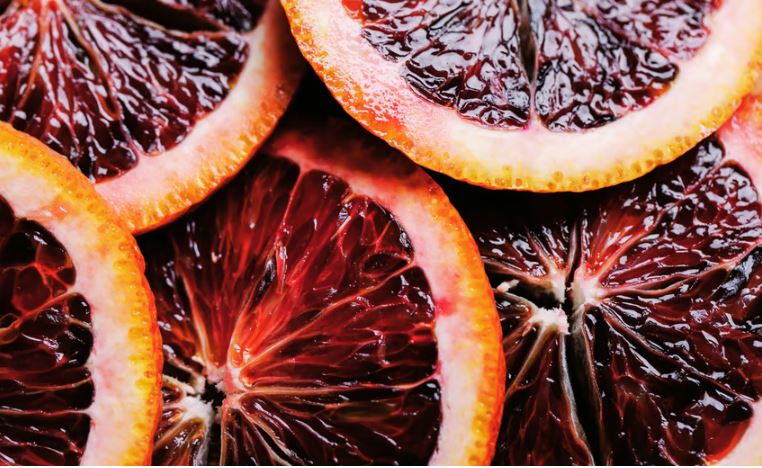
A Joyful Touch in Gastronomy
In Mediterranean cuisine, the blood orange stands out as an outstanding ingredient that adds a cheerful touch to culinary preparations. Its bold and slightly acidic flavor adds depth to fresh salads, meat and fish dressings, and tempting desserts. From jams to sorbets, the versatility of the blood orange unfolds in every corner of Mediterranean gastronomy.
Try the bold combination of Sanguinelli orange with olives, red onions, basil, and mozzarella cheese to create a refreshing salad that captures the essence of the Mediterranean. Or be captivated by its sweetness in desserts like cakes and jellies, where its crimson hue creates a visually stunning presentation.
As the Sanguinelli orange harvest season progresses, immerse yourself in the versatility of this citrus jewel and discover a world of culinary possibilities. Whether you enjoy it alone, in juices, or as part of elaborate Mediterranean recipes, the blood orange provides that gastronomic Mediterranean accent, ensuring that prepared dishes do not go unnoticed, highlighting vibrant freshness and healthy splendor. Delight your senses with the Sanguinelli orange and make every bite an unforgettable experience!
Autor: Selene.
Chocolate Navel Orange: From being an almost forgotten variety in Spain to being recovered as a gourmet fruit
From the navel orange family, the Chocolate Navel Orange stands as a variety that has conquered palates with its exquisite flavor and distinctive aroma.
Result of a natural mutation of orange trees, it has been recovered by some farmers in the Mediterranean region in the Valencian Community, in the town of Picassent (L’Horta Sur) and has made a place for itself among the most demanding palates.
The Chocolate Navel Orange, scientifically called Sinensis Citrus, stands out for its peculiar brown color resulting from the permanence of its green and orange pigments once ripe, in addition to a high degree of sweetness, reaching 12 brix, which leads it to be considered the sweetest of the navels, with a low acidity flavor. Among other characteristics worth highlighting is the high percentage of juice, its fine, shiny, soft and grainy skin, which gives way to easy peeling, from which a combined aroma of fruity and floral notes is released. Its size is medium to large within the Navel family, with a uniform rounded shape.
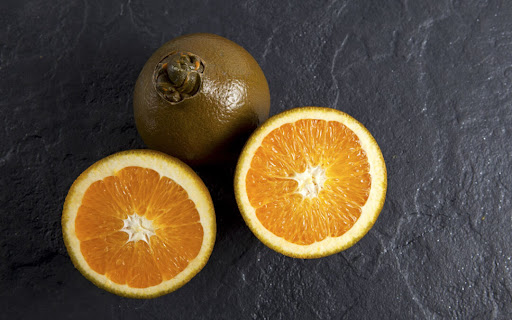
The perfect balance between acidity and sweetness makes this orange a versatile ingredient for a wide range of culinary preparations.
From jams and desserts to salad dressings and juice, Navel Chocolate Orange provides a distinctive touch that elevates any dish to another gastronomic level, as well as its natural consumption, the fruit itself, is already a pleasure.
Currently it is not easy to find in the local market, since it is grown only by a few Valencian farmers, who are betting on this ancient variety for export. But it has made a place in the palates of some countries worldwide, Holland was the first to import it in 2021 and expand it to some countries in Europe. It is currently considered a highly profitable product, due to its high price, driven by product scarcity, in addition to its low production costs compared to other citrus fruits affected by more pests, giving it a greater profit margin.
Orange also offers a number of health benefits. Rich in vitamin C, antioxidants and fiber, this fruit not only delights the palate, but also contributes to general well-being. Vitamin C strengthens the immune system, antioxidants fight free radicals and fiber promotes digestion, making Chocolate Navel Orange a delicious and nutritious option.

Chocolate Navel Orange is not only a delight for the senses, but also a nutritious addition to a balanced diet. Available in the winter season and early spring.
Its fascinating origin, its peculiar characteristics and its health benefits make it a fruit that will give that cheerful and tasty touch to our winter menu.
Autor: Selene.
Oranges: Nature's gold for your well-being
The orange is one of the most consumed fruits in the world, but do you know its origin and how it came to our markets? In this article we tell you the history of orange consumption, its properties and benefits when consuming it.
The orange is the fruit of the orange tree, a tree in the Rutaceae family that is believed to have originated in Southeast Asia about 4,000 years ago. The first records of orange cultivation date back to ancient China, where it was considered a symbol of prosperity and good luck. Arab traders introduced the orange to the Mediterranean in the 10th century, and from there it spread throughout Europe thanks to the crusades and voyages of exploration.
The orange we know today is the result of hybridization between the bitter orange and the mandarin, which was produced naturally or artificially sometime between the 15th and 17th centuries.
The sweet orange became popular for its pleasant flavor and its high content of vitamin C, which helped prevent scurvy, a disease caused by a lack of this vitamin. The orange was also used for medicinal, cosmetic and culinary purposes.
Today, the orange is one of the most produced and exported fruits in the world, with China, Brazil, India, the United States and Mexico as the main producing countries. The orange is mainly consumed in the form of juice or whole, but its peel is also used to make jams, sweets, liqueurs and essential oils.

Orange has numerous properties and health benefits, among which are:
-
It is a source of vitamin C, which contributes to the normal functioning of the immune system, the formation of collagen for the skin, bones and cartilage, and the protection of cells against oxidative damage.
-
It contains other antioxidants, such as flavonoids and carotenoids, which help prevent premature aging and protect against some chronic diseases.
-
It provides fiber, which promotes intestinal transit and the feeling of satiety.
-
It has an alkalizing effect, which balances the body’s pH and prevents acidosis.
-
It is diuretic, purifying and anti-inflammatory, which facilitates the elimination of toxins and retained fluids.
-
It stimulates the production of saliva and gastric juices, which improves digestion and prevents ulcers.
-
It has antiseptic and antibacterial properties, which helps fight respiratory and oral infections.
-
It is rich in folic acid, which is essential for the development of the fetus during pregnancy.
As you can see, the orange is a very complete fruit and beneficial for your health. We recommend that you include it in your daily diet, preferably fresh and whole to take advantage of all its nutrients.
Autor: Selene.
